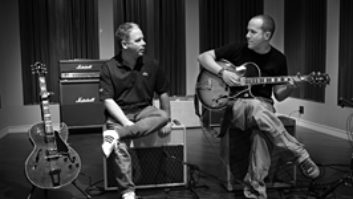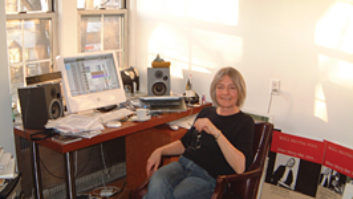In New York and throughout the world, the shock following the terrorist attacks of September 11 gave way to helplessness. People who wanted to contribute to the rescue operation, or help relieve the suffering of the relatives and friends of the victims, found there was little they could do. Studio owners, engineers, producers, manufacturers and other members of the audio profession were no exception. Their jobs seemed suddenly insignificant in light of the massive tragedy around them.
Once the shock wore off, however, the ever-resourceful leaders of our industry found ways to make a difference. Most of these efforts took the form of donations of studio time, services, equipment, etc. In some cases, companies donated portions of their proceeds for a certain period of time. And, in a few rare instances, brave members of the recording community took part in the actual rescue/recovery operation.
Two of the most high-profile, post-attack events involved studios, pro audio manufacturers, service companies, musicians and other individuals. The live telethon, America: A Tribute to Heroes, raised approximately $150 million toward the United Way’s September 11 Fund, while a remake of Nile Rodgers’ 1979 hit “We Are Family” (originally performed by Sister Sledge) contributed proceeds to the American Red Cross, the NYC Firefighter’s Relief Fund, and other entities concerned with the aftermath of the terrorist attacks on New York, Washington, D.C., and Pennsylvania.
In New York, telethon performances were held September 21 at Sony Music Studios, with live mixes handled by Saturday Night Live engineer Jay Vicari in the Effanel Music L7 truck and Effanel chief engineer John Harris in Sony’s Mix Room B. Effanel owner Randy Ezratty says, “The client allowed Effanel to bill them at our normal rate and then, with check in hand, we could donate 100 percent of our billing — a five-figure check — to September 11 charities.” Besides Effanel, other vendors included Firehouse Sound, S.I.R. and Sennheiser, according to sources.
In Los Angeles, CBS Studios hosted the telethon performances, also donating studio and staff time. Westwood One provided the remote recording facility, while AudioTek, Design FX and others supplied equipment. From stars like Neil Young and Bruce Springsteen, to the assistant engineers at the various studios, every participant in the telethon donated his or her services.
“Nobody had any qualms about donating equipment or time,” says Firehouse principal Bryan Olsen. “Our attitude was, ‘Whatever you need.’ It was all available. This was the only way people could help, and we were more than happy to be there. It was a good feeling to be able to do something.”
Production costs for the telethon — which also included performances broadcast from a London studio — were paid by ABC, CBS, NBC and Fox, according to published reports.
The day after the telethon, stars streamed into the legendary New York studio Avatar (formerly Power Station) to record an updated version of the 1979 hit “We Are Family,” again overseen by Rodgers, and again recorded in Studio A. Rodgers was joined by film director Spike Lee, who shot footage for a music video, and some 90 musicians, including Sister Sledge, Dionne Warwick, Patti LaBelle, Diana Ross, Roberta Flack, Eartha Kitt, Fred Schneider, Darius Rucker, Deborah Gibson, Ashford & Simpson, Phoebe Snow, Steve Van Zandt, Bernadette Peters and tennis great John McEnroe (who had previously recorded at Avatar).
“We got the call from Nile the night before the session,” says Avatar studio manager Tino Passante. “It was all very last-minute. Nile wanted to do it in Studio A, where the original version of ‘We Are Family’ was cut in 1979, so I checked the schedule and figured out we’d be able to make it work.”
With so many musicians in the large tracking room for Studio A and engineer Richard Hilton manning the Neve 8068 in the control room, there was no extra room for guests, journalists or other interested parties. Fortunately, Avatar was also able to make Studio B available, using the tracking area for 75 guests who could listen to a live feed of the session, and the Studio B control room for artist interviews. In addition, the Unitel facility, just down the street from Avatar, was used as a holding area for representatives of such media outlets as VH-1 and Entertainment Tonight.
“It was an incredible experience having all these artists here at the same time,” says Passante. “Most of them had worked here before, so it was like coming home to them. But they had never all been here at one time.” As far as the studio time was concerned, it never crossed Passante’s mind that it wouldn’t be gratis. “We didn’t even discuss whether we were donating the time or not,” he says. “It was automatic. The question of billing didn’t even come up.”
Kampo Studios also helped out with the remake; Rodgers and Hilton mixed the track in Studio C on the SSL Axiom-MT console. On hand for overdubs at Kampo were Vandross, Springsteen and Van Zandt.
The following day, the Record Plant in L.A. hosted members of Limp Bizkit and Orgy, the Pointer Sisters, All-4-One, Queen Latifah, Deniece Williams, Jackson Browne, Sophie B. Hawkins and Taylor Dayne for their contributions to “We Are Family.” (Rodgers himself flew out for that session, as well.)
The “We Are Family” remake was released by Tommy Boy Records, with proceeds going to the American Red Cross, the NYC Firefighter’s Relief Fund and other entities with ties to the World Trade Center tragedy.
While studios sought ways to help those affected by the terrorist attacks, at Ground Zero at least one member of the audio business took as hands-on an approach as anyone could. David Crafa, owner of the Cutting Room recording studio on Lower Broadway, put his welding experience to good use by assisting in the rescue and recovery effort. He saw harrowing sights, but kept his cool and worked hard during the weekend immediately following the tragedy. As he cut large pieces of steel to try to open up areas that might contain survivors, the famous bucket brigades carted away piles of debris pound by pound.
Sadly, neither Crafa nor any other rescuer found anyone alive after Wednesday, September 12. However, the experience of helping out left Crafa feeling like he had made a real contribution to the post-attack recovery.
“It was definitely an experience,” says Crafa, who witnessed the second plane crash and the collapse of both towers from his 34th floor apartment in Greenwich Village. “After seeeing all that and having some friends in the business asking me to go down, it was the only place I wanted to be.”
Like many studio owners whose facilities are located below 14th Street, Crafa saw bookings disappear in the aftermath of the tragedy. However, by mid-October, he was happy to report that business was starting to pick up again.
At the Magic Shop in Soho — a mere 10 blocks from the World Trade Center — two staff members lost relatives and friends in the attacks, and one of the studio’s technical gurus, Nat Priest, narrowly escaped death as he and his girlfriend fled their apartment across the street from the Twin Towers just before the collapse. Miraculously, business went on at the Magic Shop, despite the dust clouds, the security checkpoints and the surreal atmosphere.
Another session that went on as planned, against unbelievable odds, was a unique project by Peruvian artist Susana Baca at Globe Studios, on West 13th Street. The session was to have been a live recording in front of a studio audience of journalists — including members of the European press who were scheduled to be in town for the College Music Journal (CMJ) Conference — as well as representatives from the artist’s label, David Byrne’s Luaka Bop Records. The first three days — September 10, 11 and 12 — were booked for rehearsals, with tape rolling “just in case,” according to Globe owner Bob FitzSimons. Following the rehearsals, three days of recording were slated, with John Medeski and Marc Ribot augmenting Baca’s band.
The September 10 rehearsal went on as planned, with the musicians getting a feel for each other, the studio, and the production and engineering team of Craig Street and Danny Kopelson, respectively. A Belgian film crew that had been hired to film a documentary of the project was on hand, as scheduled.
Then, on September 11, things got interesting. With fear and uncertainty in the air and a lockdown state all over Manhattan — especially south of 14th Street — no one knew what to expect from that day’s session. However, according to FitzSimons, when Baca and her bandmates arrived, they told him, “Look, we live in political terrorism. We’re sad, but we must work, and you must work.”
With that, the six-day project proceded, despite difficulties by Globe staffers in getting to the studio, as well as concerns on the part of Ribot and Medeski about the air quality in lower Manhattan.
“It was the perfect distraction,” says FitzSimons. “That’s what we did for the next several days — we just worked. Even though I saw the attacks from the street as they were unfolding, I didn’t fully really realize what had happened until 10 days later. That’s when it really struck me.”
Send your NY Metro news to[email protected].



